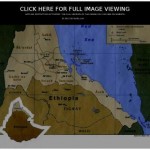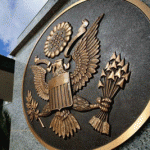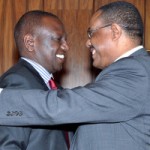A leaked Cable of US Embassy Addis Ababa reveals Ethiopia threatened to ‘reoccupy the Temporary Security Zone (TSZ), which lies entirely within Eritrea, in the event UNMEE withdrew’ back in 2004.
The Cable also indicates Ethiopia deems negotiation on ‘access to the sea’ and ‘territory swaps’ as key issues to resolve the current ‘no peace, no war’ situation with Eritrea.[Top] Amb. Kenzo Oshima and Minister Seyoum Mesfin [Bottom] Amb. Legwaila and Mrs Viki Huddleston
The Cable, prepared by the then Chargé d’affaires of the Embassy, Viki Huddleston, is a summary of a November 7, 2005 meeting at the US Embassy in Addis Ababa where Amb. Kenzo Oshima, Chairman of the UN Security Council’s Working Group on Peace-keeping Operations, gave a briefing on the status of the Ethio-Eritrean relations.
According to the Cable, the meeting was attended by diplomats in Addis representing UN Security Council members and troop-contributing countries (TCC), as well as Special Representative of the UN Secretary-General (SRSG) Amb. Legwaila Joseph Legwaila, his deputy Amb. Azouz Ennifar, and UNMEE Force Commander Major-General Rajender Singh.
The meeting was held following Amb. Oshima’s meeting with Ethiopian Foreign Minister Seyoum on the same day and his expected visit the following day to Asmara, Eritrea. Amb. Oshima defined his mission as “technical” and ‘his most important message was to push Eritrea to lift its restrictions on UNMEE’.
Background: UNMEE was established following the 1998-2000 war between Ethiopia and Eritrea, which the later started. Following the humiliating defeat by the Ethiopian army which advanced deep into her territory, Eritrea agreed that the contested areas remain under Ethiopian forces and for a demilitarized zone 25 KM deep into her territory patrolled by peacekeeping forces. That is, until the disputes are resolved, as per the Algiers Agreement signed by both parties in June 2000. Ethiopia reported to have lost slightly above 17 thousand troops in the war, though the International Crisis Group (ICG) estimates the combined loss of the two countries around 70,000.
Consequently, in 2002, the Ethio-Eritrean Border Commission(EEBC) issued a decision, which counts as border delimitation, that divided the 40 km long Badme district into two comparable areas, though the town is awarded to Eritrea.
Though the decision is unpopular in Ethiopia, the parliament adopted in 2004 a 5-point resolution accepting the ruling ‘in principle’, yet demanding the demarcation process be conducted ‘according to international norms’ and also a negotiation to resolve outstanding issues ‘in a give and take’ manner. What Ethiopia wants to negotiate on has always been a subject of speculation, as the government refused to disclose its negotiation strategy, except that a sustainable peace is the objective.
On the other hand, Eritrea continued to breach the Cessation of Hostilities Agreement and elements of the Algiers Agreement by engaging in a range of activities to destabilize Ethiopia, an allegation corroborated by UN reports.
Moreover, Eritrea continued to obstruct the operation of UNMEE, whose presence is a pre-requisite for conducting the border demarcation. In fact, Ethiopian forces withdrew from Eritrean territory at the end of the war was on the condition that a demilitarized zone patrolled by UN would be established in the Eritrean side of the border.
As Eritrea’s obstruction of UNMEE troops movement picked in 2004, so did tensions in the region, thus prompting the UN Secretary General send on Amb. Oshima, who was Japan’s UN Permanent Representative at the UN Security Council and also Chairman of the UN Security Council’s Working Group on Peace-keeping Operations.
Amb. Oshima met the then Ethiopian Minister of Foreign Affairs, Seyoum Mesfin on Nov. 7. Later that day, at the US Embassy, Oshima described the meeting as follows, according to the Cable:
Seyoum continued to assert that actual demarcation of the border would require “readjustments,” e.g., to ensure that a village not be divided in two. Seyoum also had said that the border issue was not the sole issue between Ethiopia and Eritrea: economic trade, normalization of relations, and access to the sea were also key.
Amb. Legwaila Joseph Legwaila, Special Representative of the UN Secretary-General (SRSG), who also attended the US Embassy meeting was quoted as saying:
SRSG Legwaila observed that Ethiopia had, on several occasions, proposed swapping territory, and that the final point of PM Meles’ five-point plan proposed dialogue, which Eritrea had rejected.
Commenting on the issues Oshima said:
Oshima said that while it would be useful if the GOE were to state publicly that it accepted the Ethiopia-Eritrea Boundary Commission’s (EEBC) decision as “final and binding,” as stipulated by the Algiers peace accord, the GOE continues to agree with the decision only “in principle”. Highlighting the difference, Oshima questioned whether “I will marry you in principle” meant the same as “I will marry you unconditionally.”
Amb. Legwaila Joseph Legwaila, added:
Describing himself as an “expert in linguistic contortions,” SRSG Legwaila agreed that this represented a significant caveat. Legwaila said mutual acceptance of the EEBC decision would be a good basis for parties to begin dialogue. Not accepting the finality of the EEBC decision was a violation of article 415 of the peace agreement, Legwaila added.
Oshima also made a vague remark that was presented on the Cable as follows:
According to Oshima, Eritrea’s charge d’affaires in New York had told him that the GSE had proposed a bilateral arrangement to Ethiopia, but had not pursued it further, as Ethiopia had rejected it.
Concerning the possibility of another war, Legwaila cautioned that:
allowing UNMEE’s withdrawal would be the “quickest way to war,” as the Government of Ethiopia had pledged to reoccupy the TSZ in the event UNMEE withdrew (ref A). The TSZ was intended to keep Eritrean troops 25 kilometers from the border, he said. Current restrictions hampering UNMEE’s freedom of movement, especially during the night, were thus not only “making nonsense of the Temporary Security Zone,” but also breeding suspicion, which could ultimately “force war quickly,” he said. Legwaila said movements of troops, tanks, or aircraft were a secondary concern, compared to the GSE’s flight ban on UNMEE; reversing the ban would allow UNMEE to monitor and assess such movements.
The French and Indian ambassador concurred with Legwaila’s assessment.
Legwaila also asked for satellite imagery from US, according to the Cable. He was quoted as saying:
the restriction on UNMEE flights prevented UNMEE from monitoring 60 per cent of the border. UNMEE could not determine whether Eritrea was now building up forces along its side, he said. He noted that UNMEE had requested satellite imagery from the United States (ref C), as “there is no other alternative” to aerial surveillance. Without aerial surveillance, UNMEE Force Commander Singh said he would need 15 times more troops (i.e., 45,000) to monitor the border.
















![Ethiopia to sell Yemen electricity [Yemen Post]](https://www.ethiopianopinion.com/wp-content/uploads/2014/02/electricityy-150x150.jpg)






![Police in Addis Ababa arrested Ethiopian woman for wearing fake butt pads [Satire] Police in Addis Ababa arrested Ethiopian woman for wearing fake butt pads [Satire]](https://www.ethiopianopinion.com/wp-content/plugins/top-10/timthumb/timthumb.php?src=http%3A%2F%2Fwww.ethiopianopinion.com%2Fwp-content%2Fuploads%2F2014%2F04%2FUnknown-150x150.jpg&w=&h=&zc=1&q=75)




Join Conversations